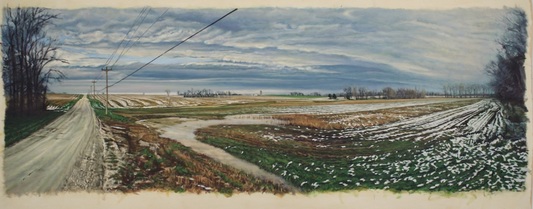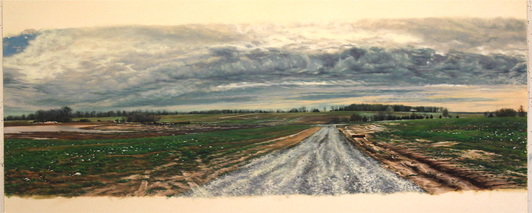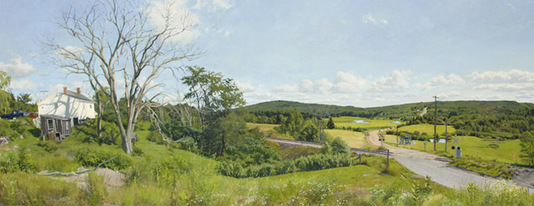 "Tracks" oil on paper 26" X 56"
"Tracks" oil on paper 26" X 56" My latest landscape painting, "Tracks", continues the investigation of how the character of the land is reflected in the remains of imposed activity - surface landmarks . It is an idea akin to empathizing with a painted human subject through awareness of the material qualities of the individual, including those physical elements like wrinkles and laugh lines that denote effects of time and exertion: one of the purports of my figure painting.
In "Tracks", multiple directional lines move us across the landscape in order to explore the topography intimately. These lines are defined by natural (snow, cloud formations) and man-made (road, utility infrastructure) indicators, as well as a hybrid of the two (snow trapped in tire tracks). The objective is movement through space and time to connect with the landscape experientially, as opposed to passively and statically. Therefore, our understanding of the subject is expanded beyond mere appearance to include history and material singularities: the realities that make each subject truly unique. It is not a moralistic exercise on environmental stewardship: the objective is simply truth.
In "Tracks", multiple directional lines move us across the landscape in order to explore the topography intimately. These lines are defined by natural (snow, cloud formations) and man-made (road, utility infrastructure) indicators, as well as a hybrid of the two (snow trapped in tire tracks). The objective is movement through space and time to connect with the landscape experientially, as opposed to passively and statically. Therefore, our understanding of the subject is expanded beyond mere appearance to include history and material singularities: the realities that make each subject truly unique. It is not a moralistic exercise on environmental stewardship: the objective is simply truth.
 untitled oil on paper 16" X 44"
untitled oil on paper 16" X 44" In support of truth, there is something very unpicturesque in the Missouri landscape which is why it attracts me. It is not unbeautiful; just more hardscrabble than Iowa, Virginia, and Pennsylvania, and, in its laugh lines and wrinkles, clearly evokes the challenges of time.
Rackstraw Downes is the king of the scrutinized landscape and another of my heroes. The man with the greatest name in art utilizes investigative painting to understand the nature of place. Painting solely by direct observation, Downes "sees" in his subjects the kind of historical and psychological mining usually reserved for portrait painting. Like Lucian Freud, who spent 75 hours a piece with his portrait subjects, the longer Downes spends with his subjects, the greater our connection with them. He demands that the immediacy of his scrutiny take as long as necessary which affirms its timelessness.
"As long as necessary" for Downes can mean weeks, months or even returning a year later when conditions are right to complete a painting. In the canons of modern art, this is another great hallmark of the perfect fusion of content and methodology.
"As long as necessary" for Downes can mean weeks, months or even returning a year later when conditions are right to complete a painting. In the canons of modern art, this is another great hallmark of the perfect fusion of content and methodology.

